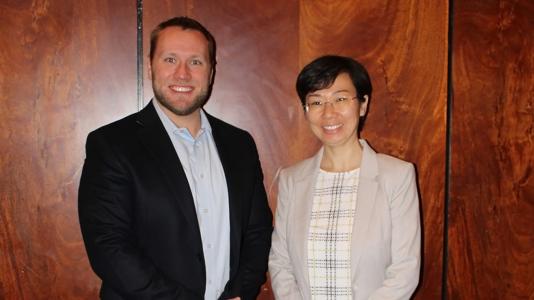
When communications giant AT&T was trying to determine what impact a changing climate might have on its infrastructure and operations in the Southeastern United States, they turned to the U.S. Department of Energy’s (DOE) Argonne National Laboratory for help.
Results of that collaboration recently earned Argonne researchers an HPC Innovation Excellence Award from Hyperion Research, which recognizes noteworthy achievements by users of high-performance computing (HPC) technologies.
“In addition to the expertise we have at Argonne, the unique parts of this project are the datasets that we already had and made available to AT&T. They are not available everywhere and not everyone can develop them in a short time period.” — Jiali Wang, Argonne assistant atmospheric scientist
Their submission, “Risk and Resiliency of Infrastructure, Southeastern USA, for AT&T,” outlines Argonne’s role in helping AT&T develop a predictive tool to help create climate resiliency responses to localized flooding.
“I’m glad that this award recognizes the initiative behind our work,” said Rao Kotamarthi, chief scientist and head of Atmospheric Science and Climate research group in the Environmental Science (EVS) division, who led the Argonne side of the project. “High-performance computing is becoming more of a necessity throughout science, and it’s essential in our work trying to assess risk from weather and climate. Argonne resources allow us to do the types of expensive computational calculations that are making a difference.”
Kotamarthi and his Argonne team, which includes assistant atmospheric scientist Jiali Wang and hydrologist Eugene Yan, are responsible for the foundational simulation data and analysis techniques that went into the development of AT&T’s Climate Resiliency Visualization Tool. High-resolution flooding models help the tool evaluate potential impacts of flooding due to both heavy precipitation and storm surges on critical telecommunications infrastructure at scales previously unattainable.
AT&T was the beneficiary of both the power of Argonne’s HPC resources and datasets that evolved, in part, from Kotamarthi’s and Wang’s work with the Department of Defense’s Strategic Environmental Research and Development Program (SERDP) from 2012 to 2015, which produced a dynamic downscale climate model for all of North America.
Using the downscaling method, Kotamarthi’s group was able to reduce grid cell resolutions from 100 kilometers to nearly 12 kilometers, approximately a factor-of-eight improvement in resolution. For the AT&T project, they took the 12-kilometer data to produce water depths due to inland and coastal flooding at dozens to hundreds of meters, using hydrological and storm surge models.
Today, Argonne is able to provide AT&T — as well as other infrastructure entities — with the highest resolution data sets currently available in North America to help in the development of adaptation/mitigation strategies for greater infrastructure resiliency.
“We have produced probability curves for AT&T that can tell them how often flooding will happen within small 200-meter grid cells and the uncertainty in these estimates for the entire Southeastern U.S.,” said Kotamarthi. “They’re using it, for example, to look at infrastructure and determine the potential risk of flooding in the coming decades. So, they’re trying to map their infrastructure based on what we predicted and assessing its usefulness.”
“In addition to the expertise we have at Argonne, the unique parts of this project are the datasets that we already had and made available to AT&T,” added Wang. “They are not available everywhere and not everyone can develop them in a short time period. The data size is about 700 terabytes and covers 300 years in terms of time slices, from historical to future periods under different scenarios.”
Beyond standard measurements for temperature, precipitation and wind, Argonne’s datasets provide many more variables like humidity, soil moisture and pressure. The larger set of variables makes it possible to develop the types of models required for inland and coastal flooding, as well as wind gusts, three areas where AT&T is currently focused.
“As an HPC user, I feel very encouraged by this award because it acknowledges not only Argonne’s technical abilities, but also the domain science experts behind the scenes who make such efforts succeed.”
Announcement of the HPC Innovation Excellence Award winners took place November 19, during the Hyperion Research HPC Market Update at the Supercomputing 19 (SC19) conference in Denver.
In addition to Kotamarthi and Wang, the Argonne team includes Keith Roberts, Eugene Yan, Julie Bessac, Tom Wall, Alissa Jared and Mark Picel.
Dataset development used in this project was funded by SERDP. Flood modeling was funded through AT&T.
Argonne National Laboratory seeks solutions to pressing national problems in science and technology by conducting leading-edge basic and applied research in virtually every scientific discipline. Argonne is managed by UChicago Argonne, LLC for the U.S. Department of Energy’s Office of Science.
The U.S. Department of Energy’s Office of Science is the single largest supporter of basic research in the physical sciences in the United States and is working to address some of the most pressing challenges of our time. For more information, visit https://energy.gov/science.